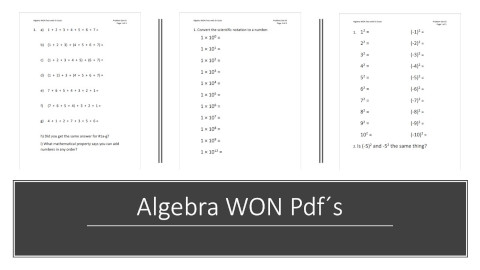Algebra 1 Topics
The Algebra 1 topics are described below in Plain English. You can find the print outs here.

Algebra 1 Topics: Hands-On
The below list describes the major topics covered in a typical Algebra 1 class. You can learn about the below Algebra 1 topics in a set of printer-friendly worksheets.
The Topics:
Order of operations: An operation in math is something that can be done to numbers. Like adding numbers, or multiplying numbers. Algebra has other operations too, such as exponents and logarithms. To get the right answer, you have to do the operations in the correct order. Doing the correct operations in the correct order is commonly known as “order of operations.”
Sign conventions: A central idea in algebra is that numbers can be either positive or negative. We put a negative sign in front of a negative number to indicate its negativity. The sign usually has major significance, and it’s important to know whether a number is negative or positive.
Negation: Negation means a change of sign. Negating a positive number makes it negative. But, negating a negative number makes it positive. Remember, negation means a change of sign. It doesn’t necessarily mean a negative number.
Expressions vs equations: Expressions contain variables, and we need to learn how to manipulate expressions to do algebra. Equations contain expressions, and only equations can be solved. This is a key difference, that there is no such thing as a solution to an expression. Only equations have a correct answer.
Real numbers: Real numbers are just your everyday concept of numbers, which include whole numbers, decimals, and fractions. Real numbers could be positive, or negative, or zero.
Solving equations for x: The goal of algebra is to solve equations for an unknown, commonly represented by the letter x. We can solve equations with an unknown variable x by using the concept of inverse operations. Inverses allow us to isolate the variable x, essentially by undoing what has been done do the variable x.
Exponents and exponential functions: An exponent means raising a number to some power. It’s essentially repeated multiplication. There are, however, special cases raising a number to the power of 0 or 1. Exponents can be negative, indicating fractions, and exponents can also be fractional, indicating radicals such as square roots.
Radicals and radical expressions: Radicals are basically referring to the concept of a square root. Other radicals such as cube roots exist as well. Radicals can also be thought of as fractional exponents.
Polynomials: Polynomials are expressions with various exponents on the variable x. An Example is x4 + x3 + x2 + x.
Distributing: Distributing is an advanced form of multiplication. The opposite or inverse of distributing is called factoring.
Factoring polynomials: Factoring of polynomials is perhaps the most important algebra 1 topics. It represents a general way to solve equations involving polynomials.
Difference of perfect squares: The difference of perfect squares is the simplest case of factoring polynomials. It’s a good place to get started learning the more advanced algebra 1 topics.
Solving quadratic equations by factoring: The purpose of factoring is to solve equations. Particularly, we focus on quadratic equations in which there is an x2 and x term but no higher powers of x. Quadratic equations come up often in the real world, and we need to solve them frequently.
The quadratic equation: The quadratic equation is an alternate approach to solving an equation by factoring. Assuming the equation is quadratic, meaning there is an x2 and x term but no higher powers of x.
Algebra 1 Topics NOT Covered in our Courses
Inequalities: Inequalities happen when we take an equation and we change the equals sign (=) to either a less than sign (<) or a greater than sign (>). This results in an annoying logic game that has little real world application. Inequalities often frustrate students because they can be difficult to visualize. As such, the study of inequalities moves in the opposite direction of our algebra 1 philosophy to show how math is actually used in the real world.
Linear equations and plotting lines: We cover these traditional Algebra 1 topics in our Algebra 2 topics and print outs.

